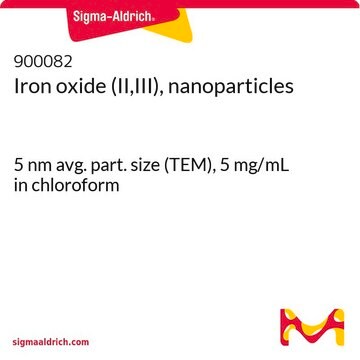Kluczowe dokumenty
725331
Iron oxide(II,III), magnetic nanoparticles solution
5 nm avg. part. size, 5 mg/mL in H2O
Synonim(y):
Magnetic iron oxide nanocrystals, Magnetite, Superparamagnetic iron oxide nanoparticles
About This Item
Polecane produkty
Formularz
dispersion
nanoparticles
Poziom jakości
stężenie
5 mg/mL in H2O
namagnesowanie
>25 emu/g, at 4500Oe
wielkość cząstki
4-6 nm (TEM)
śr. rozm. cząst.
5 nm
gęstość
1.00 g/mL at 25 °C
ciąg SMILES
O=[Fe].O=[Fe]O[Fe]=O
InChI
1S/3Fe.4O
Klucz InChI
SZVJSHCCFOBDDC-UHFFFAOYSA-N
Szukasz podobnych produktów? Odwiedź Przewodnik dotyczący porównywania produktów
Opis ogólny
Zastosowanie
Kod klasy składowania
12 - Non Combustible Liquids
Klasa zagrożenia wodnego (WGK)
nwg
Temperatura zapłonu (°F)
Not applicable
Temperatura zapłonu (°C)
Not applicable
Wybierz jedną z najnowszych wersji:
Masz już ten produkt?
Dokumenty związane z niedawno zakupionymi produktami zostały zamieszczone w Bibliotece dokumentów.
Klienci oglądali również te produkty
Produkty
A key challenge for nanomaterial safety assessment is the ability to handle the large number of newly engineered nanomaterials (ENMs), including developing cost-effective methods that can be used for hazard screening.
Professor Hui Mao explores the use of superparamagnetic iron oxide nanoparticles (INOPs) that offer an alternate contrast-enhancing mechanism.
Prof. Yadong Yin omawia różne metody syntezy nanokryształów magnetytu i ich zastosowania w różnych dziedzinach.
Professor Yadong Yin (University of California Riverside, USA) examines both direct (thermal decomposition, solvothermal, hydrothermal) and indirect (templated) synthesis methods of magnetite nanocrystals and reviews in detail the landscape of these various synthetic methods for magnetite nanocrystal and their applications in magnetic assembly, magnetic hyperthermia, and Li-Ion batteries.
Nasz zespół naukowców ma doświadczenie we wszystkich obszarach badań, w tym w naukach przyrodniczych, materiałoznawstwie, syntezie chemicznej, chromatografii, analityce i wielu innych dziedzinach.
Skontaktuj się z zespołem ds. pomocy technicznej

